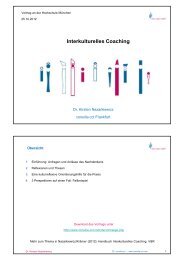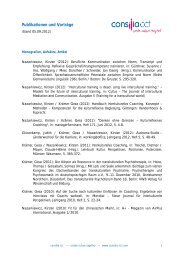Culture-reflexive conduct of talk - consilia cct
Culture-reflexive conduct of talk - consilia cct
Culture-reflexive conduct of talk - consilia cct
Create successful ePaper yourself
Turn your PDF publications into a flip-book with our unique Google optimized e-Paper software.
SIETAR FORUM BERLIN 2012<br />
Global integral competence: mind, brain, culture and system<br />
September 28th, 2012<br />
Intercultural competence through communicative work<br />
Dr. Kirsten Nazarkiewicz<br />
<strong>consilia</strong> <strong>cct</strong>, Frankfurt<br />
Download <strong>of</strong> presentation: www.<strong>consilia</strong>-<strong>cct</strong>.de/de/vortraege.php
Agenda<br />
1. Characteristics <strong>of</strong> cosmopolitan communication in training and coaching<br />
2. Typical learning hurdles <strong>of</strong> participants<br />
3. Characteristics <strong>of</strong> stereotyping and other forms <strong>of</strong> ethnocentric speech and conversation<br />
4. Intervention techniques to develop cosmopolitan communication<br />
5. Take away: A simple model to foster cosmopolitan communication<br />
Objective:<br />
Give hints how to foster global integral competence and communicative virtouosity<br />
With focus on the internalized collective aspects<br />
Some tips how to use multiple didactic perspectives in training and coaching<br />
Within a narrative and interaction approach<br />
Dr. Kirsten Nazarkiewicz<br />
Data base<br />
Different settings in view <strong>of</strong> intercultural learning<br />
Training conversations (audio recordings, German)<br />
2 two-day cross-cultural competence trainings<br />
1 two-day culture-specific training (Japan)<br />
1 one-week anti-racism course<br />
© <strong>consilia</strong> <strong>cct</strong> – www.<strong>consilia</strong>-<strong>cct</strong>.com<br />
data base for comparison: family conversations from Western and Eastern Germany<br />
All <strong>of</strong> the following data extracts stem from these data sets.<br />
Method: Ethnomethodological Conversation Analysis + own training experiences<br />
Dr. Kirsten Nazarkiewicz<br />
© <strong>consilia</strong> <strong>cct</strong> – www.<strong>consilia</strong>-<strong>cct</strong>.com<br />
2<br />
3
Cosmopolitan Communication<br />
„Further questions about the Indian“ (IKK II)<br />
95 Train.: by the way what could be tiresome in respect to time � too � is that in indian politeness<br />
96 Pet.: � yes yes�<br />
97 Train.: it is ahm very common to decline a few times before saying yes after all<br />
98 Bar.?: mh<br />
99 Train.: this is in some [countries] it's also common in belgium in england it is pretty common too<br />
100 Pet.: oh � yes�<br />
101 Train.: �ahm� that is the indirect communication you know<br />
102 Train.: oh <br />
103 Pet.: �so always�<br />
104 Train.: like that you know? so you let yourself be persuaded it's a game back and forth<br />
Activities <strong>of</strong> the trainer:<br />
Line 95: introduction <strong>of</strong> cultural value: „(Indian ) politeness“ as a background explanation<br />
Line 95: describe effects on the feelings <strong>of</strong> a person who does not share this perspective („tiresome“)<br />
Line 97: explication <strong>of</strong> concept „to decline a few times before saying yes after all“<br />
Line 99: add at least one culture as a representative (here: Belgium, England)<br />
Line 101: name the pattern with a technical term („indirect communication“)<br />
Line 102: illustrate this value with a staged example or scene<br />
Line 104: explicate perspective <strong>of</strong> persons who share the orientation (you let yourself be persuaded)<br />
Dr. Kirsten Nazarkiewicz<br />
Characteristics <strong>of</strong> cosmopolitan communication<br />
Dr. Kirsten Nazarkiewicz<br />
© <strong>consilia</strong> <strong>cct</strong> – www.<strong>consilia</strong>-<strong>cct</strong>.com<br />
© <strong>consilia</strong> <strong>cct</strong> – www.<strong>consilia</strong>-<strong>cct</strong>.com<br />
4<br />
5
Typical learning hurdles<br />
What do you experience as a challenge or typical difficulty<br />
Dr. Kirsten Nazarkiewicz<br />
in intercultural trainings?<br />
Hurdle 1: First order categories and primary frames<br />
Examples:<br />
© <strong>consilia</strong> <strong>cct</strong> – www.<strong>consilia</strong>-<strong>cct</strong>.com<br />
Participant: „that is also with the japanese, I‘ve always noticed that; cannot make up their mind“<br />
Trainer: „and when he says no then there is a de‘ for us demeaning gesture“<br />
Phenomena<br />
„Natural attitude“ (Schütz/Luckmann 1974), <strong>talk</strong> in „primary frames“ (G<strong>of</strong>fman 1974)<br />
People do not question their own cultural reality: culture-bound judgments, interpretations,<br />
misinterpretations and misunderstandings<br />
Essentialist view <strong>of</strong> culture: culture as an entity, congruence between nation, culture, ethnicity<br />
Dr. Kirsten Nazarkiewicz<br />
© <strong>consilia</strong> <strong>cct</strong> – www.<strong>consilia</strong>-<strong>cct</strong>.com<br />
6<br />
7
Hurdle<br />
Dealing with first order categories and primary frames<br />
1. First order<br />
categories<br />
and primary frames<br />
Dr. Kirsten Nazarkiewicz<br />
Characteristics<br />
identify ascriptions<br />
(something “is” like that,<br />
they “are”, he “does”)<br />
any ontological utterance<br />
Interpretation based on own<br />
cultural perspective(s)<br />
lack <strong>of</strong> knowledge and<br />
insight in other cultural<br />
horizons<br />
natural ethnocentrism<br />
stage according to Bennett:<br />
minimization or acceptance<br />
Hurdle 2: Political correctness<br />
Example<br />
„Egoistic japanese“ (IKK I)<br />
47 Clau.: the japanese they are such an ego'<br />
Not helpful<br />
more content-related<br />
information, explanations<br />
etc.<br />
48 well that's one <strong>of</strong> these prejudices again probably<br />
49 Train.: �mhamhahe�<br />
50 Clau.: � but so � egoistic I find as is hardly any other people<br />
51 Hel.: they also do this with using their elbows that way<br />
Phenomena<br />
Participants control their utterances<br />
Helpful<br />
point out perspectives<br />
meta-communication<br />
activities <strong>of</strong> cosmopolitan <strong>talk</strong> like<br />
illustrating in a scene<br />
perspective <strong>reflexive</strong> interventions<br />
constructivistic approach<br />
a dynamic notion <strong>of</strong> culture<br />
© <strong>consilia</strong> <strong>cct</strong> – www.<strong>consilia</strong>-<strong>cct</strong>.com<br />
Moral judgments about categorized groups <strong>of</strong> people have to undergo (self-critical) evaluation<br />
In particular ethnic stereotypes are subject to a generalized suspicion <strong>of</strong> being prejudiced<br />
…and even more so in intercultural training („hostile environment“)<br />
The speakers anticipate and occasionally name this norm (line 48)<br />
At the same time, one can observe an ‚urge‘to speak out the deprecatory judgments nonetheless (line 50f.)<br />
Dr. Kirsten Nazarkiewicz<br />
© <strong>consilia</strong> <strong>cct</strong> – www.<strong>consilia</strong>-<strong>cct</strong>.com<br />
8<br />
9
Hurdle<br />
Dealing with political correctnes<br />
2. Political<br />
correctness<br />
Dr. Kirsten Nazarkiewicz<br />
Characteristics<br />
self control, attempt to<br />
speak neutral / “value-free”<br />
Not helpful<br />
establish norms and<br />
taboos<br />
try to speak “value-free”<br />
Hurdle 3: „Stereotype communication“ (Nazarkiewicz 1997)<br />
Example<br />
„Normal voice“ (IKK II)<br />
47 Train: in south england are you familiar with that? that it is perfectly normal<br />
48 that women are always <strong>talk</strong>ing in this high pitch voice<br />
49 Dan.: mh they are <strong>talk</strong>ing in a tERRibly � SHRILL voice<br />
50 Barb.:<br />
51 Dan.: �the english women<br />
52 Barb.: �the american women<br />
�and also<br />
53 Pet.: �<br />
56 Train: �yes<br />
57 Dan.?: <br />
Helpful<br />
term the subject and hurdle<br />
de-stigmatization<br />
allow judgments<br />
open up topics for culture-sensitive<br />
and -<strong>reflexive</strong> discussion<br />
include oneself<br />
quote evaluations, judgements<br />
security when using<br />
categorizations<br />
differentiate between: category,<br />
type, stereotype and racistic<br />
ascription<br />
© <strong>consilia</strong> <strong>cct</strong> – www.<strong>consilia</strong>-<strong>cct</strong>.com<br />
Some characteristics <strong>of</strong> stereotype communication: „<strong>reflexive</strong> expressiveness“<br />
pro<strong>of</strong> <strong>of</strong> authenticity: stories and evidence which call for common indignation<br />
affect marking and high interaction dynamics, participation <strong>of</strong> several persons<br />
hyperbolizations, staging, naming several examples<br />
interactive safeguarding <strong>of</strong> the moralization proposals (baits), relativations, rehabilitations<br />
Dr. Kirsten Nazarkiewicz<br />
insider perspective UK,<br />
judgment <strong>of</strong> pitch<br />
lexical intensification<br />
and marking affect<br />
tie in with further cultures<br />
collective hyperbolic staging<br />
„<br />
„<br />
© <strong>consilia</strong> <strong>cct</strong> – www.<strong>consilia</strong>-<strong>cct</strong>.com<br />
„<br />
10<br />
11
Hurdle<br />
Dealing with the communication <strong>of</strong> stereotypes<br />
3. Stereotype<br />
communication<br />
Dr. Kirsten Nazarkiewicz<br />
Characteristics<br />
<strong>reflexive</strong> expressivity<br />
stage according to Bennett:<br />
defense<br />
Not helpful<br />
abstinence<br />
abort or cut short the topic<br />
give explanations<br />
participate ‘half-heartedly’<br />
Helpful<br />
quote own stereotypes<br />
recognize characteristics <strong>of</strong><br />
stereotype communication<br />
moderate<br />
modalize<br />
culture-<strong>reflexive</strong> interventions<br />
© <strong>consilia</strong> <strong>cct</strong> – www.<strong>consilia</strong>-<strong>cct</strong>.com<br />
Hurdle 4: Concept <strong>of</strong> the enemy, collective learning blockages,<br />
race constructions<br />
Example<br />
Peter: yes, so in this liberal America, (.) you know? where everything is always<br />
where all <strong>of</strong> Los Angeles is burning anyway,<br />
where they murder each other and what not, such a sheriff comes to a civilized white<br />
person, where [there is] not a single car anywhere near…“<br />
Phenomena: Concepts <strong>of</strong> the enemy and collective learning blockages (Max Miller)<br />
Black-and-white view, fight between good and evil, double scale, self-fulfilling prophecy,<br />
confirmation <strong>of</strong> one‘s own the bogeyman image<br />
Highly selective filter, monolithic perception <strong>of</strong> the other, linked with a subjective sense <strong>of</strong><br />
threat, overestimation <strong>of</strong> the other‘s unity who is stylized as an „opponent“<br />
Race constructions<br />
Classifying (groups <strong>of</strong>) people with respect to attributes that are assumed to be determined<br />
by descent<br />
Naturalization: assumption <strong>of</strong> insurmountable differences which are constructed as being <strong>of</strong><br />
natural origin<br />
Dr. Kirsten Nazarkiewicz<br />
© <strong>consilia</strong> <strong>cct</strong> – www.<strong>consilia</strong>-<strong>cct</strong>.com<br />
12<br />
13
Hurdle<br />
Dealing with concepts <strong>of</strong> the enemy, collective learning<br />
blockages and race constructions<br />
4. Race constructions<br />
and concepts<br />
<strong>of</strong> the enemy,<br />
collective learning<br />
blockages<br />
Dr. Kirsten Nazarkiewicz<br />
Characteristics<br />
partly high indirectness<br />
and implicitness<br />
Tool: Intervention Square<br />
Explicate<br />
Dr. Kirsten Nazarkiewicz<br />
Not helpful<br />
set up taboos<br />
generalized suspicion<br />
evaluate<br />
Moderate<br />
<strong>Culture</strong>-<strong>reflexive</strong><br />
<strong>conduct</strong> <strong>of</strong> <strong>talk</strong><br />
Perpective-<strong>reflexive</strong><br />
interventions<br />
Helpful<br />
include oneself<br />
step outside the discourse<br />
describe political dimension and<br />
hurdle meta-communicatively<br />
pay attention to and respect<br />
image-preserving social positioning<br />
© <strong>consilia</strong> <strong>cct</strong> – www.<strong>consilia</strong>-<strong>cct</strong>.com<br />
Solidarize<br />
© <strong>consilia</strong> <strong>cct</strong> – www.<strong>consilia</strong>-<strong>cct</strong>.com<br />
14<br />
15
Example for moderating the communication <strong>of</strong> stereotypes<br />
„Imperious African ladies“ (IKK II)<br />
TR.: where do you infer that from?<br />
(...)<br />
I pass it on to the group, do you agree with this?<br />
(...)<br />
but where do you infer that from? what gives you the impression?<br />
(...)<br />
so you would say they have a lot <strong>of</strong> things in common with us you see a lot <strong>of</strong> things in common<br />
(...)<br />
mhmhm yes I gladly pass it on to you [addressing the group]<br />
do you primarily see parallels between them and us or do you rather see differences<br />
(...)<br />
and otherwise you feel a strong connection to these women so you said I am getting back to that they<br />
acted in a bossy way can you pin that down what was the reason Arnika what might have given you the<br />
mh<br />
(...)<br />
so it legitimizes the behavior also the fact that they have a lot <strong>of</strong> money that they have a social position?<br />
(...)<br />
so the mere fact that they dispose <strong>of</strong> the financial means and hold a social position is an explanation<br />
pattern for their behaving this way or makes it easier for you to accept it<br />
Dr. Kirsten Nazarkiewicz<br />
Example for moderating the communication <strong>of</strong> stereotypes<br />
„Imperious African ladies“ (IKK II)<br />
Lau.: where do you infer that from?<br />
(...)<br />
I pass it on to the group, do you agree with this?<br />
(...)<br />
Objectives and advantages <strong>of</strong> moderating approach:<br />
fosters reflection,<br />
opens a discussion<br />
inquires information<br />
arranges a discourse<br />
helps elicitating more similar or different experiences and interpretations<br />
generates knowledge<br />
Limitations:<br />
a moralizing discourse that might evolve<br />
dealing with attributions, stereotypes and prejudices that are uttered<br />
participants expect answers (even if they would not help)<br />
Dr. Kirsten Nazarkiewicz<br />
© <strong>consilia</strong> <strong>cct</strong> – www.<strong>consilia</strong>-<strong>cct</strong>.com<br />
© <strong>consilia</strong> <strong>cct</strong> – www.<strong>consilia</strong>-<strong>cct</strong>.com<br />
16<br />
17
Intervention Square<br />
Explicate<br />
Dr. Kirsten Nazarkiewicz<br />
Example for showing solidarity<br />
„Prejudices prejudices prejudices“ (IKK I)<br />
Objectives and advantages <strong>of</strong> solidarization<br />
Moderate<br />
<strong>Culture</strong>-<strong>reflexive</strong><br />
<strong>conduct</strong> <strong>of</strong> <strong>talk</strong><br />
Perspective-<strong>reflexive</strong><br />
interventions<br />
Solidarize<br />
© <strong>consilia</strong> <strong>cct</strong> – www.<strong>consilia</strong>-<strong>cct</strong>.com<br />
2 Yv.: sometimes they have these men here such hairs in their face �(this long)�<br />
3 Hel.: � hm hm! �<br />
4 Yv.: �( )�<br />
5 Hel.: �right I also find that strange they don't cut them do they?�<br />
6 Yv.: hm hm �( � )<br />
7 Hel.: ��<br />
8 Train.: <br />
9 Hel.: � yes �<br />
10 Train.: <br />
A mindful consideration <strong>of</strong> the feelings <strong>of</strong> the speaker (and their internalized cultural values)<br />
helps creating a symmetry and being a co-learner<br />
fosters openness to <strong>talk</strong> about evaluations by establishing a good contact and relationship<br />
reduces face threat with respect to political correctness requirements<br />
supports emotional learning<br />
Limitations<br />
There is always a risk to confirm culturally bound statements when discourse is not properly managed<br />
Dr. Kirsten Nazarkiewicz<br />
© <strong>consilia</strong> <strong>cct</strong> – www.<strong>consilia</strong>-<strong>cct</strong>.com<br />
18<br />
19
Intervention Square<br />
Explicate<br />
Dr. Kirsten Nazarkiewicz<br />
Moderate<br />
<strong>Culture</strong>-<strong>reflexive</strong><br />
<strong>conduct</strong> <strong>of</strong> <strong>talk</strong><br />
Perspective-<strong>reflexive</strong><br />
interventions<br />
Example for perspective <strong>reflexive</strong> intervention<br />
„Polychronic monochronic“ (IKK I)<br />
Solidarize<br />
© <strong>consilia</strong> <strong>cct</strong> – www.<strong>consilia</strong>-<strong>cct</strong>.com<br />
383 Helga: because you have said haven't you well the [one who's] polychronic is also flexible<br />
384 (0,75)<br />
385 Helga: �(that was the)� yes<br />
386 Trainer: �he thinks he‘s� flexible (0,25) he thinks that we’re stubborn (0,25) he thinks we’re stubborn<br />
387 (0,75)<br />
388 Helga: but you are successful you just have to be in today‘s society (0,75)<br />
Objectives and advantages <strong>of</strong> culture and perspective <strong>reflexive</strong> interventions:<br />
focus on the interpretative horizon <strong>of</strong> the participant<br />
helps the individuals to cross and transcend their perspective<br />
trains culture <strong>reflexive</strong> view <strong>of</strong> the world<br />
creation <strong>of</strong> new questions<br />
fosters openness for different perspectives on the same matter<br />
reflection <strong>of</strong> premises <strong>of</strong> own judgements and perspective might follow<br />
Limitations:<br />
leads to reflection alone, no additional information given<br />
no transfer skill development<br />
Dr. Kirsten Nazarkiewicz<br />
© <strong>consilia</strong> <strong>cct</strong> – www.<strong>consilia</strong>-<strong>cct</strong>.com<br />
20<br />
21
Intervention Square<br />
Explicate<br />
= cosmopolitan<br />
communication<br />
Dr. Kirsten Nazarkiewicz<br />
Example for explicating<br />
„Further questions about the Indian“ (IKK II)<br />
Moderate<br />
<strong>Culture</strong>-<strong>reflexive</strong><br />
<strong>conduct</strong> <strong>of</strong> <strong>talk</strong><br />
Perspective-<strong>reflexive</strong><br />
interventions<br />
Solidarize<br />
© <strong>consilia</strong> <strong>cct</strong> – www.<strong>consilia</strong>-<strong>cct</strong>.com<br />
95 Train.: by the way what could be tiresome in respect to time � too � is that in indian politeness<br />
96 Pet.: � yes yes�<br />
97 Train.: it is ahm very common to decline a few times before saying yes after all<br />
98 Bar.?: mh<br />
99 Train.: this is in some [countries] it's also common in belgium in england it is pretty common too<br />
100 Pet.: oh � yes�<br />
101 Train.: �ahm� that is the indirect communication you know<br />
102 Train.: oh <br />
103 Pet.: �so always�<br />
104 Train.: like that you know? so you let yourself be persuaded it's a game back and forth<br />
Objectives and advantages:<br />
helps to educate and enlighten, enables a confrontation with different world views<br />
Limitations:<br />
emotional resistance and natural ethnocentrism<br />
not all incidents or interpretations can be decoded culturally<br />
Dr. Kirsten Nazarkiewicz<br />
© <strong>consilia</strong> <strong>cct</strong> – www.<strong>consilia</strong>-<strong>cct</strong>.com<br />
22<br />
23
Hurdle<br />
Summary: culture <strong>reflexive</strong> <strong>conduct</strong> <strong>of</strong> <strong>talk</strong> for integral competence<br />
1. First order<br />
categories<br />
and primary frames<br />
2. Political<br />
correctness<br />
3. Stereotype<br />
communication<br />
4. Race constructions<br />
and concepts<br />
<strong>of</strong> the enemy,<br />
collective learning<br />
blockages<br />
Dr. Kirsten Nazarkiewicz<br />
References<br />
Characteristics<br />
identify ascriptions<br />
(something “is” like that,<br />
they “are”, he “does”)<br />
self control, attempt to<br />
speak neutral / “value-free”<br />
<strong>reflexive</strong> expressivity<br />
partly high indirectness and<br />
implicitness<br />
Not helpful<br />
content-related information,<br />
explanations etc.<br />
establish norms<br />
abstinence, abort or cut<br />
short the topic,<br />
give explanations,<br />
join in / participate ‘halfheartedly’<br />
set up taboos,<br />
generalized suspicion,<br />
evaluate<br />
Helpful<br />
point out, metacommunication,<br />
cosmopolitan <strong>talk</strong> as culture<br />
<strong>reflexive</strong> interventions,<br />
perspective reflection<br />
remove taboos / de-stigmatization,<br />
allow judgments, open up topics<br />
for culture-sensitive and -<strong>reflexive</strong><br />
discussion<br />
recognize characteristics <strong>of</strong><br />
stereotype communication,<br />
moderate, modalize, culture<strong>reflexive</strong><br />
interventions<br />
include oneself, step outside the<br />
discourse, describe metacommunicatively,<br />
pay attention to<br />
and respect image-preserving<br />
social positioning<br />
© <strong>consilia</strong> <strong>cct</strong> – www.<strong>consilia</strong>-<strong>cct</strong>.com<br />
G<strong>of</strong>fman, Erving (1974): Frame analysis. An essay on the organization <strong>of</strong> experience. New York: Harper & Row.<br />
Miller, Max (1986): Kollektive Lernprozesse. Studien zur Grundlegung einer soziologischen Lerntheorie. Frankfurt:<br />
Suhrkamp.<br />
Nazarkiewicz, Kirsten (1997): Moralisieren über Ethnien. Die Reflexivität der Stereotypenkommunikation, in:<br />
Zeitschrift für Soziologie, Vol. 1997, No. 3, pp. 181-201.<br />
Nazarkiewicz, Kirsten (2010a): Gesprächsführung als Trainingsmethode in interkulturellen<br />
Weiterbildungsveranstaltungen, in: Hiller, Gwenn / Vogler-Lipp, Stefanie (eds.): Schlüsselqualifikation<br />
Interkulturelle Kompetenz an Hochschulen, Wiesbaden: VS Verlag für Sozialwissenschaften, pp. 87-105.<br />
Nazarkiewicz, Kirsten (2010b): Interkulturelles Lernen als Gesprächsarbeit. Wiesbaden: VS Verlag für<br />
Sozialwissenschaften.<br />
Nazarkiewicz, Kirsten (2012): Frame Management: Intercultural competence through <strong>conduct</strong> <strong>of</strong> <strong>talk</strong>, in:<br />
Interculture Journal, Vol. 12.<br />
Schütz, Alfred / Luckmann, Thomas (1974): The structures <strong>of</strong> life-world, Vol. 1, London: Heinemann.<br />
Dr. Kirsten Nazarkiewicz<br />
Thank you for your participation!<br />
Download <strong>of</strong> presentation: www.<strong>consilia</strong>-<strong>cct</strong>.de/de/vortraege.php<br />
© <strong>consilia</strong> <strong>cct</strong> – www.<strong>consilia</strong>-<strong>cct</strong>.com<br />
24<br />
25









